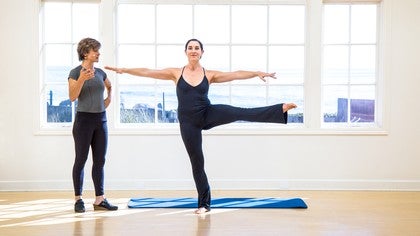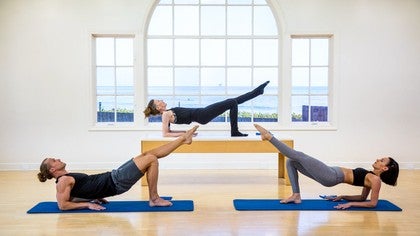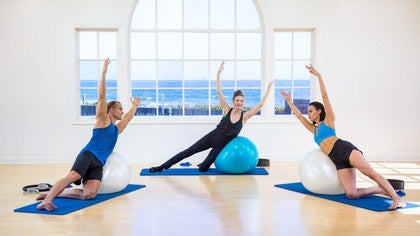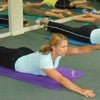Description
About This Video
Transcript
Read Full Transcript
Hi, I'm Kara. We're here at Pilates Anytime today and I'm gonna take Brianna through some direction with her turnouts so we talked about in the other ballet videos regarding how to improve turnout and how to use Pilates in that and I realize it didn't ever speak directly to, what is turnout? What angles are we talking about? It's good to be precise and defined for your own body, what you're doing on the mat with your work, and then be able to take it in every level of your work. So then, go onto an intermediate level, go onto an advanced level, but keep that foundation still active in your work and that's up to you because your teacher's trying to teach you so many things, you gotta keep it up for yourself.
So we're gonna start just sitting here and just look at a parallel line with the leg and in dancing, we talked about parallel, that was pretty much knees and top of foot being lined up to the ceiling so you could look at it. In mathematics, we talk about just a zero degree angle, and then your right angle is a 90-degree angle, so then we're gonna start to define how much do those legs move in a range of motion from this beginning line? And also when you're talking about physiology, you know, sometimes our bodies bend on an 80-degree angle, sometimes it's ten degrees, it's good to know that and what is sort of average, what is poor, you know, then it gives you an idea of what your range of motion needs to be and how you can improve it and what should be sort of a standard. So starting at zero degrees, then Brianna's just gonna stay in this zero degree line and she's just gonna turn out, so there we see how much rotation Brianna has from the top of leg bone right here, and allows her thigh to rotate out. A lot of problems that people do and they do it in their mat work, is they rotate from their knees.
Our knees have a little ability to rotate but that's not where we want to rotate from. We want to take it all the way up from this thigh bone. We put the foot corrector on our toes sometimes when we do those exercises. This is where you rotate from, the thigh, so let's just have her come back to zero degrees, now she's gonna start to deviate away from that zero degree line and she's gonna start to adduct her legs out as wide as she can, and this often is what people will refer to as turnout, because we lift our legs up and developpe and so forth and we think oh, it's out there at that angle so that must be my turnout. Well, not so.
Actually from this line, she's still in parallel. Now she can rotate out her legs, again, using her hip. And there's an extra element of rotation. We have dance teachers all our lives who try to ask us to turn our kneecaps back to the back of the wall. And that's what they're trying to ask us to do, is to open that up and use that rotation in the hip with the adduction of the leg out to the side, and then sure, when we're super fancy, we can sometimes, yeah, go wider.
Brianna's super fancy. Oh yeah. (laughing) Good, let's close your legs together, let's lay on one side. So let's just take that in just one example for sidekicks, 'cause it's really easy to see. So we start with both legs in parallel, the feet are flexed.
We maintain parallel on this bottom leg, but now this leg, we get to practice our turnout. So in this zero degree line, we're gonna turn out from her hip, rotating, and then she's gonna maintain that and this is how we raise the leg up to the side, hold it right there, good. Can you rotate some more? So that's, again, we can work turnout a little bit extra, maintain that, and lower the leg back to zero degrees. Now don't lose any of it Brianna, and raise it up with that rotation and lower it with that rotation and raise it up with that rotation and lower it with that rotation, good.
And just as an example, she can turn back parallel, she won't have as much range of motion now. She'll just raise the leg up; that's the amount of adduction that hip has, it doesn't have any more, if we want to go further, we have to be in rotation to lift it higher. And then down, good. Flip her over, let's show your back to the camera, good. And then let's just go ahead, do the other side.
So once again, starting in parallel, the feet will be flexed, she's going to turn out the leg, maintaining that turnout. She's gonna raise the leg up and hold it for me one moment. See if you can rotate back. Yeah, so can you share your kneecap with the audience? Yes, she can.
And keep that as you lower down, good, so once again, that leg is going to stay in rotation to raise up, and lower down and hope you guys are trying this as you're looking at it, don't just look at it, try it. Raise it up, keep the same amount of rotation, don't lose any of it. That's where the mind comes in, right? The concentration, one more time. Beautiful, good.
Try and parallel, just to see the difference, again, just know your angles. So raise it up and lower it down, so I would say, in rotation, she was able to go up beyond 90 degrees, turn out for me once more, good. So she went from that 90-degree angle, she went even beyond. 100, 110, 120, something like that. And then she kept it and then she went down.
But when she goes in parallel, there's maybe just 45 degrees. That's how much a hip has and it has to do with the structure of the leg, so just know that, you know, that's why we turn out the leg, it's so we can get more range of motion, good. Let's stand up in front of the mat, we'll face the cameras. And let's start in parallel, 'cause we love modern dance. (laughing) Good, so you can either, I'll take a step back, go ahead and stretch your arms outright, just be simple.
So let's just developpe the leg up and just take it out, find your 90-degree angle, that's not easy. And then try to keep that and rotate it out, good, and you can see how the leg changed and once again, we were frequently taught that we wanted to be able to lay a plate of food upon the thigh and serve it to someone and lower the leg. Good, woo! Good, other side, so stand strong down on that leg. You can developpe, oh, she's being fancy, good. And keeping the leg, good.
And then rotate it out, right. Don't tell me that leg doesn't have to work hard, but let me see the plate of food be able to be served upon, right? And lower the leg down, good. Now, think about the angle, let's stay there Brianna, that you just had to the side, when you were laying on your side, doing your sidekick, you can developpe that, it's a little bit easier. Good, so once again, she's gonna work to rotate inside that hip and serve up that kneecap to the back wall, stretch your arms long, good, and we're at about your powerhouse, oh! That's part of it, and lower down, good.
Try the other side and think about your powerhouse when you go into it and think about how your powerhouse is going to make you be able to stand in this exact position that you felt when you were laying on your side and lower down, and lower the arms, good. Good so just a brief, little presentation to show alignment. Know your angles, we have zero, we have 90, we have many between and what to use in your body, and then take that in the other videos as well when you go and practice the exercises. Thank you.
Pilates for Athletes: Pilates for Dancers
Comments
You need to be a subscriber to post a comment.
Please Log In or Create an Account to start your free trial.



-thumb-3-80947.jpg)







-thumb-3-80947.jpg)


